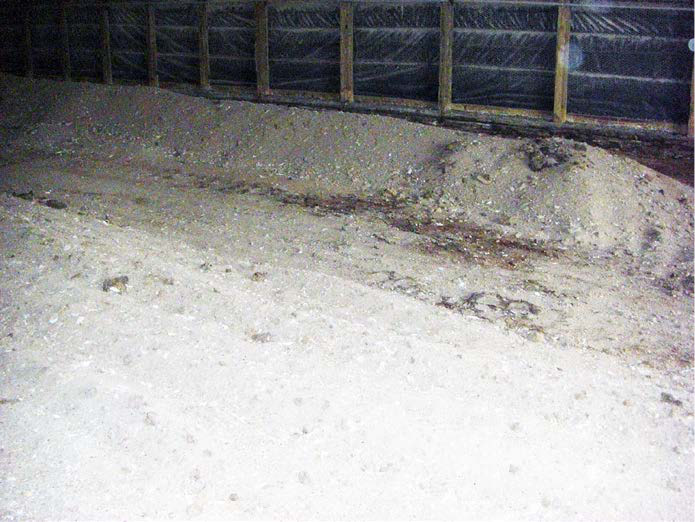Poultry Litter Management
Keeping litter dry is a critical part of overall management on every poultry farm. Litter conditions influence bird performance, which in turn affects profits of growers and integrators. Dry litter helps control ammonia levels, provides a healthy flock environment, and reduces condemnations due to hock and footpad burns and breast blisters.
Today, frequent use of built-up litter requires greater attention to detail than ever before. Poultry litter consists of bedding material (shavings, rice hulls, etc.), manure, feathers, and other components. Dry litter is important for the health and welfare of birds, as well as the people who work in the houses.
When litter begins to retain moisture it will clump together, which is referred to as caking. Why dry litter begins to cake is often misunderstood, but it is not complicated. Too much moisture within a poultry house can cause litter to cake—it’s just that simple. However, it takes a long time (days and in some cases, maybe weeks) for moisture levels in the litter to build up enough for cake to form. Moisture can build up because the ventilation rate within the house is inadequate over a prolonged period (not just a few hours).
Broilers drink about 2 pounds of water for every pound of feed consumed, or more than 50,000 gallons per 20,000-bird house each flock. Only about 20 percent of the water consumed is used for growth; most of it eventually reaches the litter as manure. To prevent caking, this added moisture within the litter must be removed through adequate ventilation. Once cake starts to form, it is difficult to reverse the process. It usually requires over-ventilation to correct the problem, which can lead to excessive gas use during cold weather and high energy costs year-round.
Caked litter also increases house ammonia levels. Negative effects of ammonia on broiler health, welfare, performance, and carcass quality have been well documented by numerous researchers (Reece et al., 1980; Kristensen and Wathes, 2000; Miles et al., 2004). Poultry are most susceptible to elevated ammonia levels at 1 to 21 days of age, which is the early brooding period (Wheeler et al., 2008). Ammonia is also a concern due to potential environmental and human health impacts of elevated levels over prolonged periods.
Adequate ventilation and use of litter amendments are two practices that help control ammonia volatilization (Payne, 2012). Unfortunately, growers often underestimate ammonia levels if they depend on their eyes and noses for detection. Most growers become somewhat desensitized to ammonia after long-term exposure, making it difficult to accurately gauge ammonia levels in their houses. This can result in decreased bird performance and serious welfare issues. Handheld ammonia sensors are available, although the technology is somewhat expensive ($300 to $500 range). However, sensors can help producers accurately manage ammonia levels.
Litter pH affects ammonia release and should be below 7 to reduce volatilization. However, litter not treated with an acidifying agent will often have a pH near 8 or slightly higher. Therefore, many growers use acidifying litter treatments just before flock placement to lower pH for a flock’s first few days. However, it is difficult to control pH over an entire flock, in part because litter treatments only last 10 to 14 days in most cases, and reapplication with birds in the house is impractical (Wheeler et al., 2008).
Good litter and air quality can be maintained with proper ventilation, but it has to start when the previous flock goes out and continue throughout the new flock. The trick is to stay one step ahead while being as efficient as possible. No one wants to over-ventilate with high fuel prices, but under-ventilating can be even more devastating when it results in lost performance, health concerns, and welfare issues.
Preventive fan maintenance can help keep your ventilation program as efficient as possible. Make sure fan belts are not in need of replacement, and check belt tensioners on a regular basis. Keep fan blades and louvers/ shutters clean and bearings greased. Maintain proper static pressure and check air speeds on a regular basis.
Also check for air leaks to ensure the house is tight. Air leaks affect the ability to pull an adequate static pressure. Static pressure is the difference in air pressure between inside and outside the poultry house. Leaks usually occur around sidewalls, end doors, and tunnel curtains. These leaks can create drafts and cool spots at floor level, where cake forms rapidly and chicks can easily become chilled.
Keeping litter in good condition and avoiding caking are extremely important because of the high cost of litter, and because disposal of this litter is becoming more of an environmental issue. In some areas, many growers still practice a traditional total cleanout once a year. This method results in broiler litter that usually tests approximately 60-60-50 (N-P-K) pounds per ton (Payne, 2012). This litter is then used locally as fertilizer on pastures and hay meadows, or shipped out of the area for use as fertilizer elsewhere.
However, it is becoming more common for growers to reuse litter for multiple years if no disease problems arise. In-house windrowing and partial house cleanout are two methods aimed at re-using litter for an extended period.
In-house windrowing is a process of forming litter into approximately two windrows (18 to 24 inches in height) in between flocks and turning windrows at least once, preferably 5 to 6 days apart (Figure 1). If done properly, high temperatures (greater than 130°F) are achieved by microbial action within windrows (pasteurization), which can effectively reduce litter pathogen populations and disease risks. Windrows should be leveled at least 4 to 5 days before chick placement to allow for ammonia release associated with litter’s cooling down and drying out.

The second method is known as partial house cleanout. Partial house cleanout is removing a limited amount of litter from the middle of a house when needed and redistributing the remaining litter throughout the house.
Re-using litter will be more important in the future as land application of litter becomes more scrutinized because of its environmental impacts, especially in relation to phosphorus runoff and its potential role in accelerating eutrophication (Sharpley et al., 2009). In addition, new bedding materials are a significant cost to the poultry industry and its growers—a spreader truckload of shavings costs $260 (McLoud, 2012) and a walking floor trailer of shavings costs $1,000 to $1,300 delivered (Ezelle, 2012), with up to three loads required initially to put significant bedding depth in a 25,000-square-foot house.
In order to ensure healthy and profitable broilers, growers must maintain dry litter. Wet litter greatly increases pathogen load and, therefore, chances of a disease outbreak that may require a total cleanout. However, barring a major disease challenge, some poultry complexes never require a complete cleanout, but rather only need close management of litter depth (Malone, 2006).
Eventually, a stable microflora population is established that does not tend to change with increasing flocks on built-up litter (Thaxton et al, 2003). This multiyear build-up of litter can be beneficial by providing a deeper insulating layer of litter with greater moisture absorbency that will generate more heat during winter. However, in-house litter will eventually require at least a partial removal.
Litter production on an Arkansas farm averaged 2.4 pounds of litter per bird placed over an 18-year period, or 16.98 pounds of litter per square foot of floor space per year (Tabler et al., 2009). However, litter production can vary greatly from farm to farm based on house size, harvest weights, management practices, number of flocks per year, and so forth.
The important thing to remember is always keep litter dry. Adequate ventilation will achieve this goal, so don’t skimp on the air, even when birds are small. It’s less expensive to burn a little extra gas early to maintain dry litter than to fight ammonia and wet litter and the negative consequences associated with them throughout the flock.
References
Ezelle, A. 2012. Personal communication.
Kristensen, H. H. & C. M. Wathes. 2000. Ammonia and poultry welfare: A Review. World’s Poultry Science Journal, 56: 235–245.
Malone, B. 2006. Managing built-up litter. Proc. Midwest Poultry Federation Conf. March 21–23. St. Paul, MN.
McLoud, D. 2012. Personal communication.
Miles, D. M., S. L. Branton & B. D. Lott. 2004. Atmospheric ammonia is detrimental to the performance of modern commercial broilers. Poultry Science, 83: 1650–1654. Payne, J. 2012. Litter management strategies impact nutrient content. Poultry Practices, 2(1): 1–3. Oklahoma Cooperative Extension Service.
Reece, F.N., B, D. Lott & J. W. Deaton. 1980. Ammonia in the atmosphere during brooding affects performance of broiler chickens. Poultry Science, 59: 486–488.
Sharpley, A., N. Slaton, T. Tabler, K. VanDevender, M. Daniels, F. Jones & T. Daniel. 2009. Nutrient analysis of poultry litter. Arkansas Cooperative Extension Service, Publ. number FSA9529. 6 pages.
Tabler, G. T., Y. Liang & K. W. VanDevender. 2009. Poultry litter production and associated challenges. Avian Advice, 11(2): 8–10.
Thaxton, Y.V., C. L. Balzli. & J. D. Tankson. 2003. Relationship of broiler flock numbers to litter microflora. Journal of Applied Poultry Science, 12: 81–84. Wheeler, E., K. Casey, R. Gates, H. Xin, Y. Liang & P
Topper. 2008. Litter management strategies in relation to ammonia emissions from floor-raised birds. Proc. Mitigating Air Emissions from Animal Feeding Operations Conf. Iowa State University. May 19–21. Des Moines, IA.
The information given here is for educational purposes only. References to commercial products, trade names, or suppliers are made with the understanding that no endorsement is implied and that no discrimination against other products or suppliers is intended.
Publication 2738 (POD-09-21)
By Tom Tabler, PhD, former Extension Professor, Poultry Science, and Jessica Wells, Assistant Clinical/Extension Professor, Poultry Science.
The Mississippi State University Extension Service is working to ensure all web content is accessible to all users. If you need assistance accessing any of our content, please email the webteam or call 662-325-2262.




